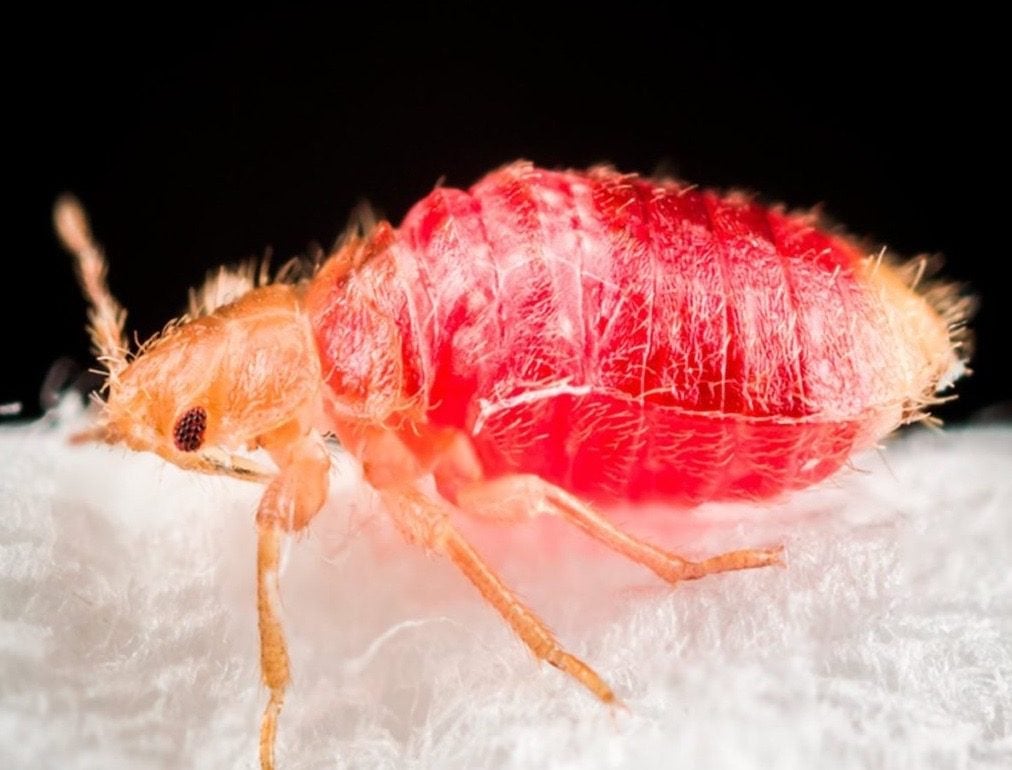
The truth about bed bugs
Bed bugs—just the thought of them makes you itchy, doesn’t it? These tiny critters feed on human blood and love to hide in and around the cracks and corners of our beds. And even though they don’t carry disease, they do cause a red, itchy rash.
When were the first bed bugs recorded?
These bugs have been around for thousands of years. Scientists have fossilized bugs that are more than 3,500 years old. Its believed they originated in the Middle East, in caves that were used by both humans and bats, and in the ancient world they were often used as a home remedy.
Do they exist everywhere?
Bed bugs can be found all over the world, but perhaps surprisingly, the worst infestation problems tend to occur in developed countries where people use bed frames and soft bedding. Between 1930 and 1980, they were almost eliminated because chemicals like DDT were used to tackle infestations, but since DDT was banned, there’s been a huge increase. Many are now immune to today’s pest control chemicals. And increased levels of international travel are helping fuel the problem, as bedbugs can travel on clothing and in suitcases and bags.
Where are the worst outbreaks of bedbugs?
As of 2017, the top 10 bed bug infested cities are: Toronto, Winnipeg, Vancouver, Ottawa, St. John’s, Edmonton, Halifax, Sudbury, Scarborough and Calgary.
What’s the best way to get rid of them
Bed bugs are very difficult to eradicate, especially the eggs, so first it’s important to try and prevent an infestation in the first place. But once they’re established, they breed rapidly. An adult will lay around 250 eggs in their life cycle and they only take six to 10 days to hatch.
Next, check out the most disgusting house bugs—and the best ways to get rid of them.

The truth about dog coat genetics
If you have a dog, chances are you’ll agree they’re more than pets—they’re part of the family. Keeping your fur baby around for as long as possible is a priority, so take note: You could be feeding your dog all the right foods, giving him the proper amount of exercise, and smothering him with love and affection, and he still may not live as long as you’d wish. And the secret to his longevity may be linked to the colour of his coat.
New research from the University of Sydney studying Labrador retrievers found the chocolate breeds don’t live as long as their yellow and black counterparts. The reason for this, said lead author Professor Paul McGreevy, from the University’s Faculty of Science, may be recessive genes. (Can you guess this dog’s breed based on one picture?)
“The relationships between coat colour and disease may reflect an inadvertent consequence of breeding certain pigmentations,” he told Science Daily. “Because chocolate colour is recessive in dogs, the gene for this colour must be present in both parents for their puppies to be chocolate. Breeders targeting this colour may, therefore, be more likely to breed only Labradors carrying the chocolate coat gene.”
According to the study, which took place with Labradors living in the United Kingdom and is currently being replicated in Australia, the median longevity of non-chocolate Labradors is 12.1 years, more than 10 per cent longer than those with chocolate coats. Researchers tested more than 33,000 Labradors across the UK in conjunction with the University’s VetCompass Program. In addition to lifespan, Labradors with chocolate coats are also more apt to suffer health issues, such as ear infections and skin diseases.
No matter what colour your Labrador may be, researchers noted that many of these dogs tend to be overweight, regardless of colour. So there is something you can do to keep your furry friend as healthy as possible for as long as possible—monitor his diet to prevent obesity.
Certain labs may be prone to health issues but on the upside, they’re one of the smartest dogs around. Here are the smartest dog breeds, ranked.

The real reason dogs chase their tails
Dogs have tons of strange quirks, from spinning in circles before they poop to kicking up the lawn afterward. But among the weirdest: chasing their own tails around and around.
It might look like a strange activity to humans, but tail-chasing is a way for dogs to burn off some steam. In most cases, they’re whirling for one of two reasons: They’re bored or they’re stressed, says certified dog behaviour consultant Russell Hartstein, founder of Fun Paw Care.
If a dog doesn’t have anything (or anyone) to play with, it might need to entertain itself—in this case, by playing with its tail. On the other end of the spectrum, the behaviour could be a warning sign that your pooch is anxious or stressed. “We call these displacement behaviors, similar to a human twirling their hair or tapping their foot,” says Hartstein. “They seek to do self-soothing behaviours.” (Don’t miss these other secrets your dog’s tail is trying to tell you.)
One reason tail-chasing can be a go-to for dogs is that they start playing with their tails as playful puppies learning about their bodies. Owners laugh at the activity, so the dog learns it can get attention when it whirls, says Hartstein.
It’s normal for dogs to chase their own tails every now and then, but watch out if your pet is doing it every day or it seems to become an obsession. A constantly bored or stressed dog might be feeling neglected, so make sure its basic needs are being met, including exercise and socialization. (Here are more things your pet wishes you knew.)
A visit to the vet is also a good idea. If the tail-chasing started suddenly, your dog might be reacting to a medical issue, like cognitive dysfunction, epilepsy, or tapeworm, says Hartstein. The sooner you get a medical checkup, the better. “A lot of times, parents think, ‘If I just wait, it will get better on its own,’” Hartstein says. “But [behaviours] get more intense; they get more ingrained.” With some treatment and extra training, you and your pooch will both be happier.
Can you guess this dog’s breed based on one picture?

Here’s why you should never pick your nose
No one wants to admit to nose picking, but that doesn’t mean people don’t still have this gross habit. In addition to the obvious sanitary issues, experts say digging for gold could damage your health. According to research published in the European Respiratory Journal, picking your nose could easily spread a dangerous pneumonia-causing bacteria.
Researchers from the Liverpool School of Tropical Medicine studied how people contract pneumonia with the help of 40 healthy volunteers. The volunteers were split into four groups and were exposed to the bacteria using different hands-to-nose methods. The new research found that pneumonia-causing bacteria can spread through picking and rubbing the nose. Science Daily notes that this is the first study showing transmission can occur from contact between the nose and hands after exposure to the bacteria, rather than just through breathing it in. (Here are 50 ways to avoid catching a cold this season.)
Plus, the study found that the bacteria spread at the same rate whether people pick their nose or simply rub it with the back of their hand. One of the lead researchers, Victoria Connor, MD, says pneumococcal infection is a major cause of death around the world. It’s responsible for an estimated 1.3 million deaths in children under five, annually, according to Dr. Connor. This infection can cause pneumonia as well as sepsis and meningitis, per the National Foundation for Infectious Diseases.
The results emphasize the importance of keeping good hand hygiene to avoid exposure to bacterial pathogens and various other illnesses, says Nesochi Okeke-Igbokwe, MD, a physician, and health expert. “Here is the takeaway—if you are guilty of having a nose-picking habit, don’t ever underestimate the potential health dangers you may actually be digging yourself into,” she says. Potential nose-picking dangers include frequent nosebleeds and recurrent respiratory infections, according to Dr. Okeke-Igbokwe. In some cases, it may also lead to nasal septum perforation or nasal vestibulitis.
Next, check out the seven body parts you’re not washing the right way.

Are you at risk for dementia?
Whether or not you tend to remember your dreams, everyone can recall that most terrifying nightmare. Maybe you were being chased by someone or something. Or you were late for a big exam. Or all your teeth fell out. Whatever it was, you probably woke up in a panic, only to realize (with enormous relief) that it was just a dream. But if you tend to have scary dreams often—and, even more telling, if you frequently scream, kick, or thrash around in your sleep—your brain could be at risk.
Frequent nightmares could be caused by REM sleep behaviour disorder (RBD), a condition that causes patients to physically act out violent dreams. Researchers have found that more than 80 per cent of RBD patients eventually develop a neurological disease, such as Parkinson’s or dementia. (Learn the 50 habits that reduce your dementia risk.)
“For some reason, the cells in the REM sleep area are the first to be sickened, and then the neurodegenerative disease spreads up into the brain and affects the other areas that cause disorders like Parkinson’s disease,” John Peever, PhD, the neuroscientist at the University of Toronto who led this new research, told Live Science. “REM behaviour disorder is, in fact, the best-known predictor of the onset of Parkinson’s disease.” (Find out 25 things your dreams reveal about you.)
Two studies from 2013 also found that more than 80 per cent of RBD patients developed a neurodegenerative disorder within a decade, but those studies were only able to show correlation. The more recent study, which was presented at the Canadian Neuroscience Meeting in 2017, proves causality.
And while RBD is terrifying for those who suffer from it, the condition could help doctors identify who’s most at risk for other neurodegenerative disorders. According to Peever, the next step in his research would be to develop a drug therapy that can treat patients who have been diagnosed with RBD. “Such a therapy would likely not cure the patient of RBD, since the brain cells that cause that disorder would have already been damaged,” he told Live Science, “but it could prevent the disease from spreading to the rest of the brain.”
Scientists still have a long way to go before they eliminate neurodegenerative disorders. But there are a few things that they know can help prevent these conditions.
Next, check out the early signs of Alzheimer’s every adult should know.

The terrible truth about James Bond
James Bond may have more than 60 years of experience saving the world from notorious villains, but he’d have a tough time getting a job in MI6 today, says Alex Younger, chief of Britain’s Secret Intelligence Service, in the Guardian. Apparently, there’s more to being an SIS officer than expensive cars, martinis and tuxedos. (It’s no wonder why James Bond is the role Burt Reynolds regretted turning down the most.)
Even if Bond’s appreciation for the finer things in life were qualification enough, his recklessness on the job would likely cut his career short. “The violence, mayhem, and death that seem to follow Bond wherever he goes are certainly one thing that would have gotten him early retirement from any reputable intelligence service long ago,” says Alexis Albion, the International Spy Museum‘s lead curator. “Also, his tendency to use his own name, lack of communication with headquarters, wanton waste of government resources, lack of discretion in his sexual dalliances… the list goes on.” In other words, James Bond would make a terrible spy.
Think about it. It’s hard to be effective at espionage when everybody knows who you are. Agent 007 is the most famous spy in the world, yet he rarely wears a disguise and almost always uses his real name. Even if “Bond, James Bond” is actually a code name, why use it over and over again?
There’s also Bond’s inability to stay under the radar. Real-life spies go out of their way not to draw attention to themselves. Bond, meanwhile, is a magnet for attention. Just look at the types of luxury vehicles he drives: Aston Martins, Audis, Bentleys, Rolls-Royces. They’re way too eye-catching, and probably too fast; Bond’s need for speed is yet another problem. To quote Q in GoldenEye, “Need I remind you, 007, that you have a license to kill, not to break the traffic laws.” (Check out the 12 greatest spy movies of all time.)
Then there’s the simple fact that Bond is an alcoholic. British researchers report that 007’s weekly alcohol consumption is over four times the recommended limit for an adult male. They also suspect that Bond suffers from alcohol-induced hand tremors as a result of all that drinking. That could explain his preference that his vodka martinis be “shaken, not stirred,” when, in fact, they should be stirred, not shaken.
Finally, 007 has a pretty terrible track record of getting captured by his enemies. Alec Trevelyan—aka Janus, from GoldenEye—even captured him twice! And how many times do you have to drink a poisoned beverage to learn that you shouldn’t consume anything given to you by your enemy? Fool me once, shame on you. Fool Bond twice, shame on 007.
Next, here’s every James Bond movie ranked—from worst to best.

RD iPod Touch Prize Draw 2021_winners
RD Apple Picking Prize Draw 2021_winners
Share Your Opinion 2020_winners
RD Survey Prize Draw Oct 2020_winners
Share Your Opinion 2020_winners
Reader’s Digest iPod Touch Prize Draw 2020 winners
Reader’s Digest Apple Picking Prize Draw 2020 winners
Holiday Basket Contest 2020_winners
RD Research Prize Draw March 2020
RD Newsletter Research Prize draw 2020 winners
Win A Book Club Prize Worth Talking About Nov 2019 winners
Holiday Basket 2019 Contest winners
2019 iPod Touch Prize Draw winners
Reader’s Digest Apple Picking Prize Draw 2019 winners
Ireland Is Waiting For You Prize Draw 2019 winner
Reader’s Digest Survey Prize Draw May 2019 winners
Canada’s Greatest Pet Contest 2019 winner
Premium Mother’s Day Basket Prize Draw 2019 winners
iPod Touch Prize Draw 2018 winners
Reader’s Digest Letter of the Month (April 2019 issue) winner
Reader’s Digest Letter of the Month (March 2019 issue) winner
Reader’s Digest Cover Test Prize Draw Oct 2018 winners
Reader’s Digesr:Sélection Editorial Research Draw Aug:Sept 2018 winners
Reader’s Digest Apple Picking Prize Draw 2018 winners
Canada’s Greatest Pet Contest 2018 winner
Express Cash 2018 – 77th Sweepstakes winner
Prestige Prize 2018_77th National Sweepstakes winner
Thank You Prize Contest 2018 winner
Letter of the Month _Aug 2018 winner
Letter of the Month (Oct 2018) winner
Letter of the Month (Sept 2018) winner
Reader’s Digest Apple Picking Prize Draw 2017 winners
RD Newsletter Research Drawing Nov 2017 winners
Holiday Basket Contest 2017 winners
Reader’s Digest Editorial Survey Prize Draw Sept 2017 winners
Driver’s Seat Sweepstakes (2017) winners
RD Jackpot Prize Draw Aug 2016 Winner
RD iPod Touch Prize Draw (Sept 2016) winners
Special Prize Contest 2015-2016 winner
RD Letters to the Editor Write+Win (Jan:Feb 2016) contest winner
RD Letters to the Editor Write+Win Contest (Nov:Dec 2015) winner
RD Holiday Basket Contest (2015) winners
RD Trusted Brand Prize Draw (Sept:Dec 2015) winners
Express Cash Series A – 75th National Sweepstakes_winner
RD iPod Touch Prize Draw (Aug 2015) winners
RD Trusted Brands Prize Draw (Summer 2015) winners
RD Healthy Summer Beauty Faves Prize Draw (2015) winners
RD Letters to the Editor Write+Win Contest (Summer 2015) winner
iPod Touch Prize Draw (Oct 2017)
Thank You Prize Contest 2016 Winner
Letters to the Editor Write + Win (Aug:Sept 2017) winner
RD Letters to the Editor Write+Win Contest (May 2015) winner
RD iPod Touch 32 GB Prize Draw (Feb:Mar 2015) winners
RD Consumer Feedback Prize Draw (Feb 2015) winners
RD Trusted Brand Prize Draw (Jan:Apr 2015) winners
In It Together Contest (Jan 2015) winner
RD Easy Cash Prize Draw 2015 winner
RD Pin It To Win It! Prize Draw (2015) winner
RD So Good’s Not Your Smoothual (2015) winners
Thank You Prize Contest 2013-2014 winner
Special Prize Contest 2013-2014 winner
Contests and Draws Winners from 2003 to 2014.pdf

Is back cracking harmful for you?
Whether you do it on purpose or by accident, you can “crack” your back the same way you crack your knuckles—and that doesn’t mean you’re fracturing or cracking bones or cartilage. The sound indicates the shifting of spinal joints, says chiropractor Chris Vargas, DC. “That cracking sound that people hear is the release of gas bubbles within the spinal joints,” he says. When your spine is out of alignment, the joints can swell and fill with bubbles that may pop when you move certain ways, according to Dr. Vargas.
These gas pockets of nitrogen, oxygen, and carbon dioxide in the joint fluid reaccumulate over time, which is why we can’t usually crack the same joint several times in a row, according to Joshua Scott, MD, primary-care sports medicine physician at Cedars-Sinai Kerlan-Jobe Institute in Los Angeles. According to Dr. Vargas, the back tends to crack after you’ve been stuck in the same position for a long time—especially if you’re hunched or slumped. For example, he notes, after you’ve been sitting at a desk all day, your back may pop as you straighten, bend, or move about and your spine shifts back into its normal alignment. (Here are five of the best exercises for seniors to build strength.)
Although back cracking can be a happy accident, some people do it intentionally, Dr. Vargas explains. Typically, they do it to relieve discomfort caused by misalignment, he says. Sometimes people will twist or move in a way they know will pop their spinal joints simply because it feels good, according to the experts at Atlantic Brain & Spine. Researchers found in a 2011 study that people associate the sound of releasing joints with relief—even if the adjustment doesn’t do much. Some chiropractors claim that cracking your back can release feel-good substances called endorphins. (As for how to relieve chronic back pain—here’s our best advice.)
Despite how good it may feel to crack your back, most experts agree that doing it frequently isn’t worth the temporary relief: Habitual back crackers could end up with chronic back pain from damaged discs and nerves; the repeated twisting may cause excessive wear on your spinal joints, experts say. The primary concern is that popping your back may not address the root of your spinal issues—especially since you could be manipulating the wrong joints, warns chiropractor William Charschan, DC, CCSP. Many people who crack their backs daily actually have spinal subluxation—their vertebrae are misaligned, according to Dr. Vargas. Cracking your back only moves the joints that are compensating for the subluxation. “So over time, they will make the primary problem worse, or they will wear down the compensating joints,” he says. (Learn the common causes of back pain.)
Although routine back cracking could do more harm than good, the occasional pop—like the once you might experience after a long day of sitting—is no cause for concern. “If you are moving your spine through normal ranges of motion without the use of any additional force, and you happen to hear that cracking sound, this is considered safe,” Dr. Vargas says. “Outside of that, any introduction of force to a spinal joint should be performed by a chiropractor.”
Dr. Scott notes that people who crack their backs once in a while are unlikely to hurt themselves: Your body naturally limits your movements to protect the spinal cord. However, repetitive and habitual back cracking can stretch the ligaments around the spine, allowing excessive movement, joint instability, and an unstable body, says Dr. Scott.
This teacher’s back pain turned out to be a life-threatening condition.

With legalization just around the corner, many Canadians have questions about cannabis. Unlike brushing up on their wine knowledge, however, they may feel slightly more apprehensive starting a conversation about cannabis at a dinner party. But like so many other things surrounded by stigma, knowledge goes a long way to demystify any myths masquerading as facts.
From the differences between chemical compounds found in this multi-use plant, to methods of consumption and some of the effects cannabis has on the body, it’s important to begin the process of getting to know this much-discussed plant.
We spoke to Chris Wagner, CEO at Emerald Health Therapeutics, to help shed some light on some of the mysteries and misconceptions surrounding cannabis.
1. What’s the difference between CBD and THC?
Cannabidiol, commonly referred to as CBD, and tetrahydrocannabinol, better known as THC, are two of the naturally occurring compounds found in plants belonging to the Cannabis genus. While their molecular structures are very similar, these compounds interact with the body’s endocannabinoid system quite differently.
The key difference between the two? CBD is a non-psychoactive compound; therefore, it doesn’t produce the high associated with THC.
“Cannabis has all these different cannabinoids in it. Everybody’s heard of THC, which is the only one that actually gets people high, and we think that the other 100+ [compounds] don’t,” says Wagner.
These two unique compounds can be isolated, giving consumers the option of abstaining from most psychoactive side effects associated with cannabis, while enjoying the many benefits.
2. Can you overdose on cannabis?
Simply put, cannabis overdose in adult consumers is unlikely.
“From a human physiology point of view, there’s never been a documented case of somebody dying by taking too much cannabis. You can get very uncomfortable, but you’re not going to die,” explains Wagner.
However, consumers still need to use caution after consuming and abstain from operating a vehicle (much the same as when consuming alcohol) and should store the product properly if they live with children or pets.
3. How does cannabis consumption affect the body?
There are many factors that influence how a substance affects the body, such as an individual’s previous experience with it, their genetic makeup, how it’s consumed, and of course the product’s properties. Other factors to consider include additional medications an individual is taking and other pre-existing health conditions.
Wagner explains that Emerald’s typical customer is someone who is consuming cannabis for a specific purpose, “whether it’s they want to relax, or they want to get a good night’s sleep, or they want to reduce pain, whatever is their reason […] they depend on us to help them achieve that purpose.”
4. How/what methods can you use to consume cannabis?
While smoking and ingesting food products that have been prepared with cannabis (known as edibles) are the two most common ways to consume cannabis, there are more products being developed now that consumption is nearly legal. Topical ointments, lotions, and balms containing CBD are being used to treat physical ailments and injuries, and even CBD bath bombs and bath salts have been developed to aid in deeper relaxation without producing a high.
5. Does the strain of cannabis I choose matter?
There are two common strains of cannabis plant, called cannabis indica and cannabis sativa, which are generally associated with different physical features as well as producing different effects when consumed.
However, Wagner cautions against depending on a strain for specific results. “A strain is not specific enough to know that you’re going to get a consistent outcome. Whether you want to relax, or [you’re using it for] pain relief, strain is not good enough. You need to know the amounts of cannabinoids.”
Because cannabis is a natural product, strains are unlikely to be the same in every crop. With legalization, Wagner expects to see greater consistency in the products created, though emphasizes that consumers should choose products from a trusted and reputable company over a “craft grower” for consistent results.
6. What are some of the benefits of consuming cannabis?
Cannabis is mostly consumed recreationally, but many have consumed it to ease symptoms caused by other illnesses. Many consumers claim that it helps with loss of appetite, sleeplessness, nausea, seizures, and chronic pain from injuries or medical conditions.
Wagner adds, “I am shocked at the number of people—and quite often, they’re mostly over fifty—who come up to me and say, ‘Oh, I’ve been using CBD.’ Or, ‘I’ve been smoking cannabis for pain, and it’s super effective.’”
Talking your doctor is always the first step before beginning a new method of treatment for any symptoms you’re experiencing, and as with products like alcohol, cannabis should be consumed in moderation. Reading more information from trusted sources and talking to professionals will help you decide if consuming cannabis is right for you.

With Halloween upon us, TV screens are flooded with scary movie marathons and theaters are inundated with thrill-seekers pursuing the latest frightening film. And then there are those select few people who absolutely despise scary movies. Fortunately, if you’re one of them, we have good news for you: it’s totally normal.
There are a few different factors contributing to why someone might hate the same scary movie that someone else might love. It’s no surprise that one of the reasons stems from childhood experiences and the amygdala, the part of the brain that controls your fight-or-flight response.
“Some people, when they were growing up, for one reason or another, have a more active amygdala. And those people, the amygdala is much more developed than others,” Kelley Hopkins-Alvarez, Licensed Professional Counselor and board-certified coach, told Reader’s Digest. “The origin of why/how the amygdala is more active is usually found in trauma that someone may have experienced, including but not limited to, attachment and bonding deficits from early caregivers, birth trauma, neglect, malnutrition, poverty, substance abuse, etc.” (Find out the nine signs of burnout.)
Another reason may be because some people are just “wired” differently. In other words, some people simply have a higher tolerance to anxiety and fear than others. This “wiring” may also coincide with childhood-based experiences. “I once had a client who shared with me that when they were young they used to watch scary movies alongside their mother, and this made them feel safe, and that sometimes they even laughed together at the scary scenes,” says Hopkins-Alvarez. “They definitely had a sense of what was reality and what was fantasy.”
Scary movies also trigger increased adrenaline production in the body and an overall boost in brain activity. This sensation can be experienced either positively or negatively, depending upon the person experiencing it. Those experiencing a positive reaction allow themselves to thoroughly enjoy the thrill and increased heart rate. In fact, this increased heart rate can even burn calories. For others, achieving this level of enjoyment is much harder, if not impossible. In fact, the excess adrenaline may trigger anxiety and panic attacks, thus resulting in negative and sometimes traumatizing experiences.
Another theory that may come into play for those with an overactive amygdala is the excitation-transfer theory. Psychology Dictionary defines this as, “Aggressive responses [that] are intensified by arousal from other stimuli not directly related to the original stimulus that started the aggression.”
“For people with that overactive amygdala, they can develop a generalized anxiety that pops up whenever there is an unknown,” says Hopkins-Alvarez. “This can either be directly after watching something like a scary movie [or] hearing a song that triggers them back to an earlier memory…”
Lastly, while it is not true that all of those who experience negativity associated with scary movies are highly sensitive people, most do tend to fall into that category. A highly sensitive person (HSP) has a tendency to be overstimulated by their environment—whether it’s due to bright lights, stress, social situations, etc. This does not exclude scary movies, where a HSP may experience the intensity at an entirely different level than those who are not highly sensitive. (Are you a HSP? Take the self-test.)